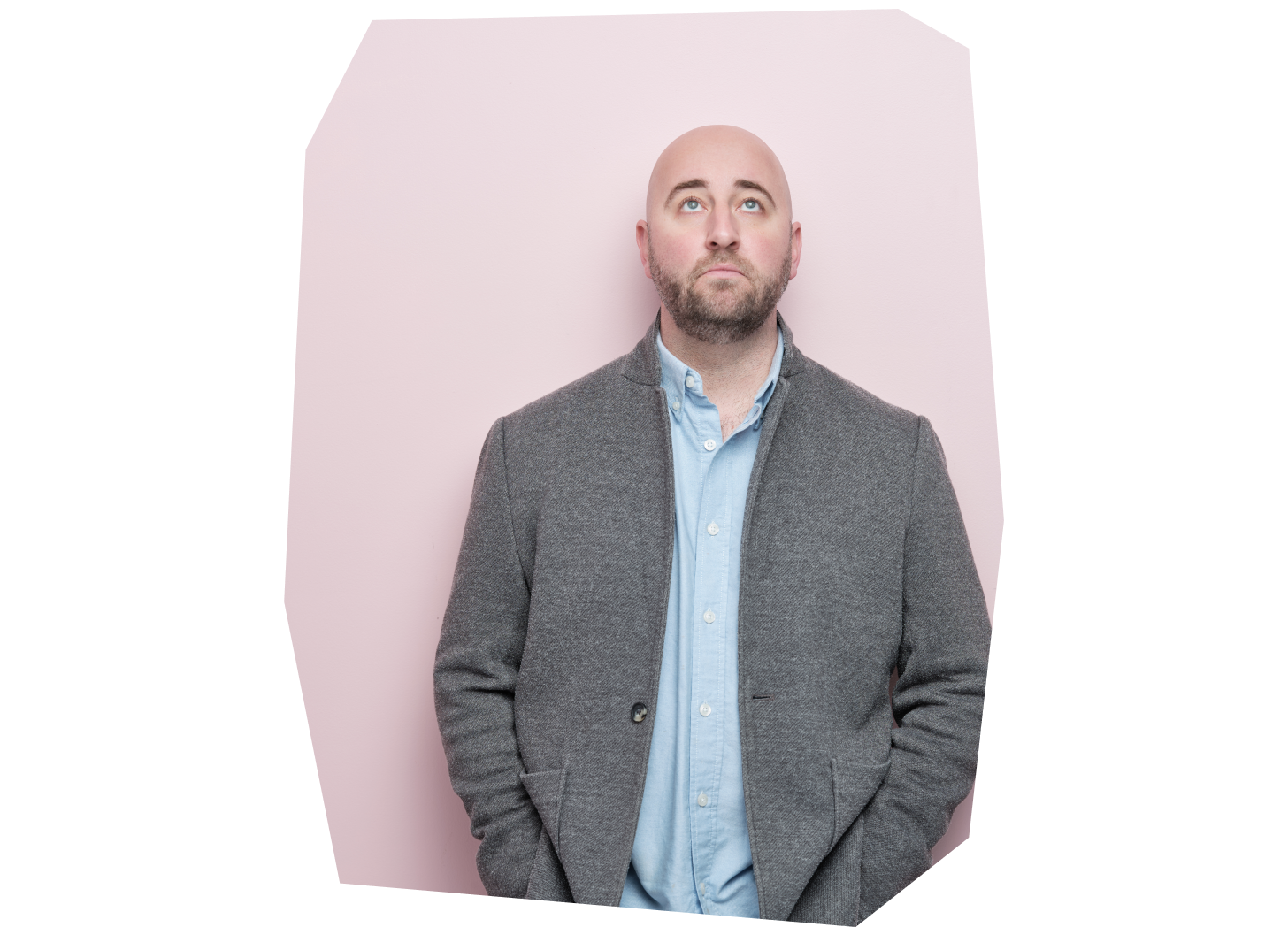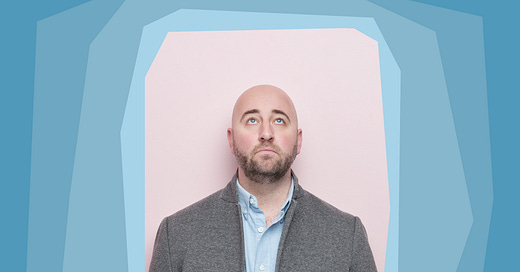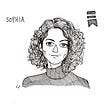A Substack is a book’s best friend: An interview with Luke Burgis
Sophia Efthimiatou speaks to author Luke Burgis about getting to know his readers through Substack and creating steady sales for his book through continued conversation

“When people tell you what they want, they tell a version of the Romantic Lie,” Luke writes in his book Wanting, which was inspired by the late French literary theorist René Girard’s concept of mimetic desire. “The Romantic Lie is self-delusion, the story people tell about why they make certain choices: because it fits their personal preferences, or because they see its objective qualities, or because they simply saw it and therefore wanted it.”
What I wanted—or at least what I thought I wanted—when I reached out to Luke was to learn more about the relationship between his book and his Substack,
, because he credits the latter for the steady sales that Wanting has enjoyed long after its publication date. This is interesting to me because I have a tendency to tell myself many romantic lies, and one of them is that books—the physical kind, whose pages are powered by our saliva—will never, ever die.For a while now, my colleagues and I have been hearing stories from writers and publishers alike that writers’ Substacks prove to be the best assets when it comes to promoting their books. More so than social media, on which their publishers advised writers to build a presence in anticipation of a book’s publication. There are writers who are especially gifted as public personas, but I would argue that most are not or have no interest in being. It is not that they don’t welcome the attention but that they want their book to receive it: the work represents the best of them. Besides, they have just spent a number of years living in sweatpants to produce it. Now they are asked to wear real clothes, do something with their hair, and be comfortable, or worse, pleasant, in the spotlight to promote it. They must smile a lot and answer questions such as What are your writing rituals? They must do whatever it takes to romance the algorithms of Twitter and Instagram, or look up “current TikTok trends” and perform six-second choreographies to promote their grief memoirs.
So it sounds refreshing that a Substack could take care of all that. It also makes sense: with their Substacks, they have a direct line to their most committed readers, and a space for the new ones who discover them by reading their books.
We looked at the data internally, and this claim is supported by numbers: to start, the average Instagram account sees an engagement rate of 1% to 5%. Meanwhile, on Substacks, we see open rates in the 30% to 70% range, depending on the size of the mailing list. Book links in posts of Substack writers get click rates ranging from 5% to 15%. This is a stunning number compared with the typical 0.08% to 0.1% on social media. After running this experiment with a bookseller, one Substack writer found that 26% of the readers clicking on her book link actually bought the book—another record-breaking number compared with book reviews from magazines and other outlets.
But what came out of my conversation with Luke was more substantial than all of this. The picture he paints is one of a flourishing community of old and new readers of his book Wanting—readers who are his cheerleaders, thought partners, and, ultimately, creative collaborators for his next book.
Whether you are a writer or a reader, I hope this conversation gives you hope: there is a booming economy for writers here at Substack, with positive spillover effects in the book industry.
“Here we are almost two years after Wanting was published,” Luke told me, “and there’s a steady drip of people that are discovering it. Substack is an amazing tool for discovery.”
Here is my conversation with Luke Burgis, and may you want, like really-really-want, to read it below, or listen to the full interview via the voiceover audio.
“Here we are almost two years after Wanting was published,” Luke told me, “and there’s a steady drip of people that are discovering it. Substack is an amazing tool for discovery.”
Sophia: What came first? Did you think, Oh, I should start a Substack because I have a book coming out?
Luke: I definitely wanted to promote my book. But the real reason that I started a Substack was mimetic desire, frankly. I saw a writer that I really like who has a great Substack called
. His name is . He was writing essays and looking like he was having a lot of fun doing it. And I was deep in the throes of editing the proofs for my book. And I had just finished with that, and I was like, “Wow, this looks very refreshing to just be able to spend my Saturday mornings writing evergreen essays on whatever I want to write about.”I was done with the book stuff for a little while, but I still wanted to promote the book. So I, on a whim, launched the Substack one morning, and I just roughly tied the theme to what my book was about. I launched it to have some fun and to try to create a larger ecosystem of ideas that were tangentially related to my book.
And you had six months to build this up and get some readers in?
Right. And they came in much faster than I was expecting, which was terrifying, especially when I didn’t even realize I had the paid option on. And I got some supporters, some paid supporters. So that gave me an added sense of responsibility to serve them well and to continue writing. So at one point I realized that I could use my Substack as a way to put and publish all of the extraneous ideas that didn’t make it into the book, just because the book would’ve been 200,000 words if I said everything I wanted to say.
So did that perspective change once you started writing a Substack and realized what it really is from the inside?
One hundred percent. I realized that the Substack transcends the book and that I had perennial evergreen things that I wanted to talk about. My readers helped me realize that. And when I started to engage them by doing things like open threads and a monthly Zoom for paying subscribers, I realized who was reading, and it completely blew my mind and my expectations. It is a very diverse group of readers that were highly engaged in the work, and they were interested in these questions, many of which were not in the book. They didn’t know it because the book wasn’t published yet.
My book is about one specific topic of human desire, namely mimetic desire, but the topic of human desire is bigger than that. And I didn’t want to limit myself. So in a way, my Substack gave me freedom to talk about all these important things that I wanted to talk about. And it was really important that I set it up in such a way that it wouldn’t be limited to one book and that people wouldn’t confine me to talking about the topics in that one book. And my readers helped me figure out how to do that.
I realized who was reading, and it completely blew my mind and my expectations. It is a very diverse group of readers that were highly engaged in the work, and they were interested in these questions, many of which were not in the book. They didn’t know it because the book wasn’t published yet.

Usually writers live in isolation when they write a book and then they put it out to the world, and it’s only then that they can see some of the reaction to it, and that reaction comes from book reviews, or from Amazon comments, or any discussion they see on social media. But it sounds like the conversation for you started practically six months before the book was even real.
Exactly. In that sense, I wish I’d started my Substack when I was starting to write the book, because I would’ve used it for this real-time engagement and discussion to work out ideas: Does this make sense to you? Is this clear? Should there be a chapter about this? So I’m looking forward to that for the next one, by the way.
Substack is alive during the writing process in a way that a book isn’t. Writing a book feels a lot like running a marathon alone where you don’t have people on the sides of the street cheering for you. You’re just totally alone. And it can be a lonely place, where the Substack process is very, very different from that. And the readers were engaging me in a different conversation than the one I had in the book. Writing a book is like . . . 80,000 words is roughly the length of my book, and I’m putting it out there, no idea who’s going to read it.
And there’s really not great channels for feedback for a book. I’m sure there are Amazon reviews. I don’t even read them, to be honest with you. I’m very intentional about that. But in Substack it’s very different. It’s a very dynamic conversation. And my book became very much, in the terms of my Substack, a “by the way.” “By the way, I wrote a book that’s kind of related to the theme of my Substack.” Rather than the other way around, rather than, “By the way, I have a Substack that’s around the topic of my book.” It was like the Substack was driving the discussion.
You used the word “cheering.” It’s true that your readers on your Substack are like your cheerleaders, because they’re there just for you. They’re subscribing to your consciousness specifically. So it makes sense that they’re giving you this encouragement to just keep going.
What I often hear writers say when they are in the process of writing a book and they consider starting a Substack is that the Substack would be competing for their attention. But you’re saying that they shouldn’t look at it that way. They should see it as an amplification of their efforts. Can you expand a little bit on that? Because everyone has a limited amount of time.
When I’m writing a book, I have thousands of pages of notes and research and ideas that I’m crafting, and they just stay in my Google Drive and often don’t go anywhere.
And it doesn’t really take me a lot of extra time to hit “send” [on a Substack post]. Readers can follow on the writing journey. And I’m simply going to warn them, “You’re not going to be getting polished stuff here, but I want you to see the things that I’m thinking through as I’m going through the writing process.”
My regular essays each week are pretty long, I think, often 2,000 words plus. They’re just going to get shorter so I can focus. But they’re going to be plugged in, in some way, to the things that I’m already thinking about for my book. And my writing helps me think and helps me figure out what I’m trying to say.
The part in my experience that writers hate the most is the marketing part. The moment of publication is a very exciting moment for them because, finally, their babies are out in the world, but then they have to go on social media and promote it. How does your Substack take care of that more organically?
I know the pressure as well as anybody that an author gets to go get blurbs and to get people to tweet about it and all that stuff. And on the pub day, my Substack was saying, “Please buy my book.”
But I think what I’ve learned is that writing the Substack, it doesn’t feel like marketing at all to me. It did a little bit in those few months leading up to the publication. But it quickly becomes something different, because the shelf life of that stuff is very short. My primary motivation was to start a conversation, an important conversation. And the Substack was a way for me to continue that conversation in a way that the hardcover itself would not allow me to do.
My primary motivation was to start a conversation, an important conversation. And the Substack was a way for me to continue that conversation in a way that the hardcover itself would not allow me to do.
But a nice side effect was that you actually ended up selling a lot of books.
I did. And this is where I think publishers are still trying to figure out what Substack is and how authors can use Substack and how it can complement their books—I think some publishers feel a little threatened by Substack. Because you can have authors that are doing so well with paid subscriptions that they’re making more in a year than a lot of publishers are able to pay in advance. A lot of publishers view it as a double-edged sword.
In my case, Substack has solved the problem of the flash-in-the-pan pub date. A book is in many cases treated like a movie release, where it’s like, “Get as many sales as you can in the opening weekend.” And in the first three months of when the book comes out. And there are so many books that are published every year that pretty soon nobody’s talking about it anymore.
Substack has really solved that problem. My sales have been steady if not growing because it’s a continual conversation. So it’s introduced some continuity and stability; the book was released and people are continuing to find the Substack, and Substack’s community platform and network effects are tremendous for that. So readers are finding my Substack and then, through it, my book.
Here we are almost two years after Wanting was published, and there’s a steady drip of people that are discovering it. So Substack is an amazing tool for discovery.
I am noticing that publishers are changing their minds about Substack. Two years ago we were competition; now we’re more of an ally. And I think they’re seeing that it just amplifies the writer’s efforts and also works for the publisher’s interests.
Every publisher, every editor is looking for authors that are willing to put in work. Not just marketing work, but just work disciplined—continuing to write, continuing to work through the ideas. Because we all know that a book is a finite thing; it can only be so many words. And I think that seeing the effort I was putting into the Substack was something that [my editor] appreciated.
And I can’t speak for other publishers, but I’m just so grateful for Tim [Bartlett, my editor], and the folks at St. Martin’s [Press] that they see the value of it. And he’s connected me to other writers of his. And we writers often don’t help each other as much as we probably should.
Substack does seem to be the kind of community where writers want to help other writers. That’s one of the coolest things about it.
Absolutely.
The amount of collaborations that I’ve done, those have been some of the things that have driven the most growth. Having the opportunity to guest-write on Bari Weiss’s Substack (
), things like that. There’s just a real feeling that the cross-post team collaboration, interviews, letter writing between two authors, that’s something that Substack has opened the door to.Whereas before, I might not know any of the other writers that my editor has, but now I do. And we’re having a conversation about how we can help each other.
That’s our goal, to create more space for writers and an ecosystem where they can organically support each other. And for readers too, to be able to fall in love with more voices and discover them through the writers that they already trust. So it’s heartwarming to hear you say that, because that’s what we’re here to do.
What’s the advice you would like to leave writers or even aspiring writers with? What is your philosophy or way of approaching a Substack?
The first thing that I learned was that if I’m not having fun, I’m doing something wrong. It’s not that it doesn’t take discipline; it does. But there should be joy in it, and you can make it your own. So I’ve gone through periods where I’ve thought that I needed to conform to a certain structure or form, and that hasn’t been true. There’s so much freedom to try different things within the Substack ecosystem. Different formats, media, interviews, all different kinds of things. There’s a lot of room to play.
So I think, to see it as that, as a wonderful opportunity to experiment, to try things out—they won’t all work, and that’s okay. That has been a really eye-opening thing for me to realize. It takes the pressure off, and I wake up on my Saturday mornings now, I pour myself a cup of coffee, and I spend a few hours really having fun and experimenting, and my readers are kind enough to know that I’m a bit unorthodox. I don’t have a rigid schedule. They never quite know what they’re going to get, and that’s okay.
So the beauty of it is that you can make it truly your own. We’re all different as writers; we’re all going to have a different relationship, if you’re an author, between your Substack and your book. Mine is very unique, and yours will be too.
If you’re inspired by Luke to start a Substack, writing your first post is just a few clicks away:








“Wanting” is definitely going on the wishlist. Audiobook listeners - he narrates it!
Great piece, and lovely to see that Substack is now being seen as an ally to books rather than a competitor. I've found Substack introduces a slowness to reading again - this facilitates a depth of processing that other forms do not promote - they grab attention, you find the latest horror on the bird site circulates around and around your working memory, is updated, replaced by something new, and lost. I've also found that the regular practice of writing a Substack hones your productivity in all sorts of positive ways.
Can you name the last ten tweets you read? Almost certainly not. But a piece like this - it will be read, lingered over, and re-read. Hugely valuable - especially if you have a book coming out.
CoI: I have a book coming out on the 3rd August, and I blurb it each week in my Substack pieces (it's on how conversation, memory, and imagination intersect to create our shared worlds - a 'neurons to nations' journey: https://www.penguin.co.uk/books/442354/talking-heads-by-omara-shane/9781847926487).